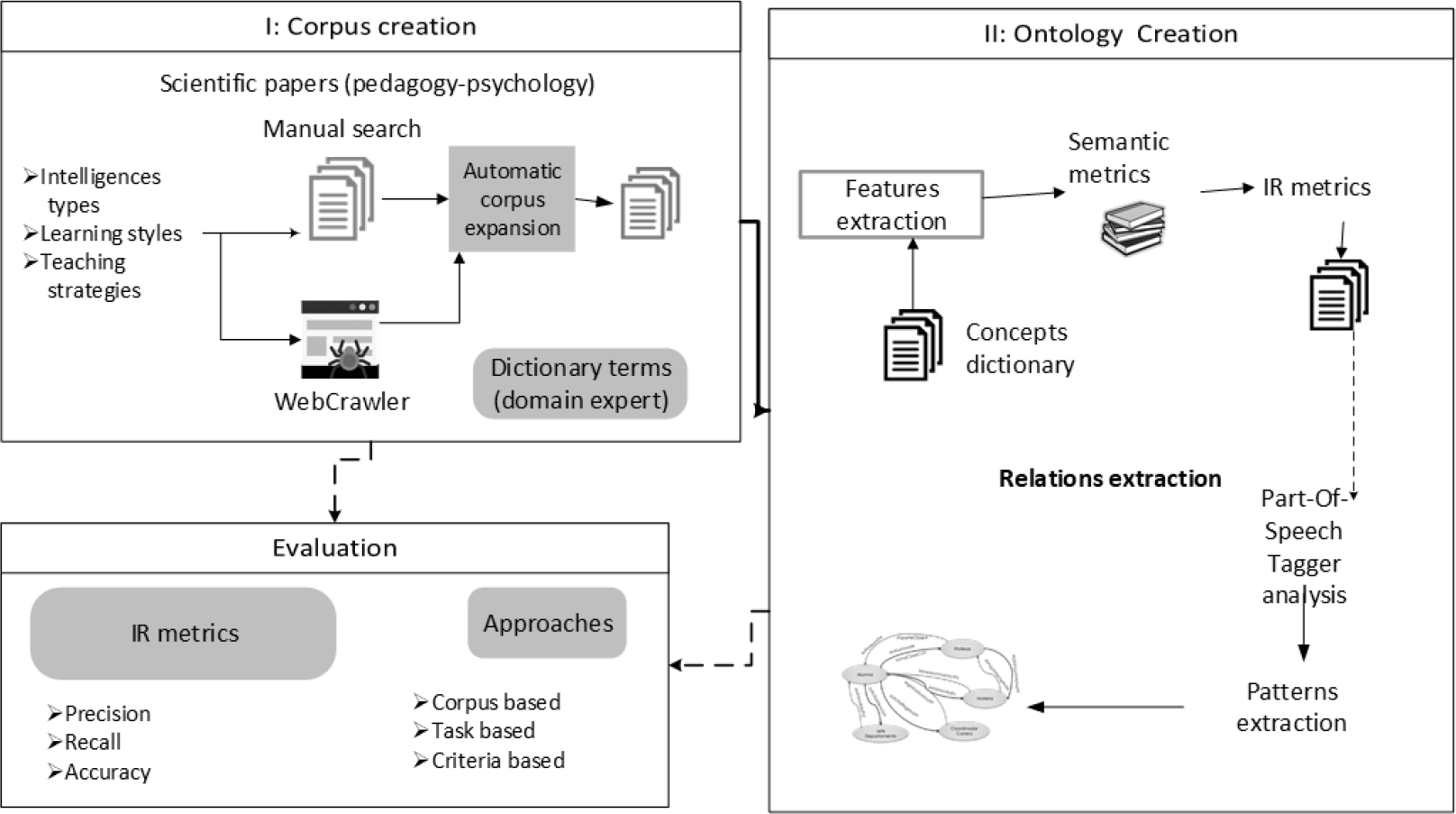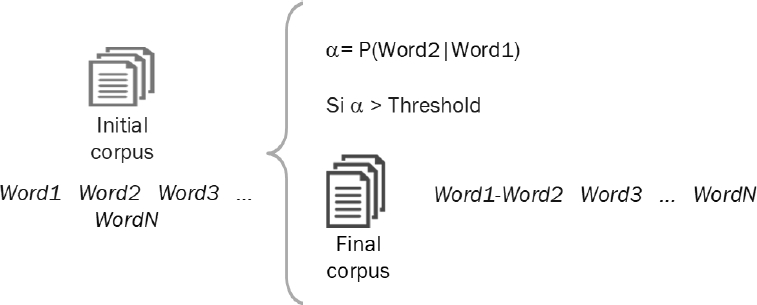1 Introduction
Natural Language Processing (NLP) defines a collocation as an expression consisting of two or more words that correspond to some conventional way of say things. Collocations have important in NLP such as information retrieval, parsing, and principal concepts detection, among others. Also, collocation extraction is the first step in many specific tasks. Some of the techniques for collocations detection includes semantic metrics [2], ontologies [3], statistical models [5] and the use of external resources depending of the language [4].
In other areas as image preprocessing, there are techniques that can be used in NLP, for example, the method by Otsu assumes that the original image contains pixels from two classes, whose intensity distributions are unknown. The goal is to find a threshold q such that the resulting background and foreground distributions are maximally separated, which means that they are (a) each as narrow as possible (have minimal variances) and (b) their centers (means) are most distant from each other [1].
This work is focused on the variance analysis to create groups and obtain collocations. The motivation behind the use of a threshold for creating different classes is grounded on the analysis of words pairs frequency. There are words that always appear together but the frequency is low and there are not collocations, the analysis by groups is necessary for deleting the groups with low o null variance.
A pedagogical corpus in Spanish was used for the experiments, afterwards, a simple frequency and conditional probability were calculated; this process lets to divide the words pair in quartiles, and get the variance by group. As evaluation, a principal concept list was matched with the results, as well as a list of pairs validated by an expert in the domain.
This article is organized in five sections described as follows. Section 2 presents related works about collocations and threshold detection for classification. In section 3, experiments are carried out followed by a detailed discussion of results in Section 4. Finally, Section 5 outlines conclusions and future work of the research.
2 Related Work
In [2], a rank aggregation method for collocations detection task was proposed. This method consists of applying some well-known methods such as Dice method, chi-square test, z-test and likelihood ratio. Then, aggregating the resulting collocations rankings by rank distance and Borda score. The proposed aggregation method performs better then each individual method taken in isolation.
In compound concept detection area, some authors proposed a novel ontology-based Compound Concept Semantic Similarity calculation approach called CCSS which exploits concept constitution features [3]. In this method, the compound is decomposed into Subject headings and Auxiliary words, and the relationships between these two sets are used to measure the similarity. By experiment, the relationship between statistical models are explored.
Some likelihood intervals methods, likelihood ratio test, and
In image processing area, variance analysis is used for image segmentation, especially for thresholding. Some techniques such as Otsu method use this analysis for separating pixels image in two classes, black and white pixels. In [6], two-dimensional (2D) Otsu method was used to correct the Otsu threshold in segmenting images of low signal-to-noise ratio, this method completely removed the noise in renal biopsy samples images.
3 Method and Experiments
Figure 1 shows the general methodology for ontology learning process in pedagogical domain. Three classes corpus was analyzed to obtain important concepts. Afterwords, these concepts were joined to design an ontology, which is focused in the first step of the methodology: Corpus creation.
Corpus was created by a Web crawler to retrieve academic papers in Spanish. Those papers are focused in one of the following topics: Intelligence types, learning styles or teaching strategies. For obtaining principal concepts, a gold standard created by a domain expert was designed. Some of the principal concepts are composed by two or more words, then, a methodology for extracting automatically collocation was necessary.
Figure 2 shows the general design for automatic
collocation detection process. The main idea is based on the selection of a
threshold named
Figure 3 shows experimental process for the experiments. It consists of two steps, each of them gets a threshold; first through the frequency and then through the conditional probability. Two steps were implemented due to there are three-words collocations, then, first a two-words collocations were obtained, afterwards, these collocations were analyzed with its neighbors.
The initial corpus is composed by 207 academic papers in Spanish about intelligences types, learning strategies and learning styles. This paper shows learning styles class results, with 83 papers.
After the method stops, the candidate list is evaluated using a gold standard (203 words) and the analysis of a domain expert. For preprocessing step, stop words were deleted and a lemmatizer was used for obtaining lemmas. Finally, texts were separated in bigrams.
According to Figure 3, in each of the iterations, the pairs of words were ordered by frequency or conditional probability variance. Afterward, the quartiles were obtained, finally, the general variance and per quartile were calculated and compared with the general variance. The hypothesis is that if a group of words has a low variance, these pair of words are not representative for the principal topic, and is not necessary consider them like a collocation.
4 Results
In this section, a detailed discussion about results is presented. Table 1 shows data per quartile in first iteration, that is, number of quartile, minimum and maximum frequency, number of instances (the same for each quartile), frequency average and variance. Quartiles contain 24,022 pairs of words, most of them have a frequency of 1.
Table 1 Frequency results (first iteration)
| Quartile | Minimum frequency | Maximum frequency | Frequency Average | Frequency Variance |
| 1 | 2 | 3,054 | 4.729 | 22.8531 |
| 2 | 1 | 2 | 1.038 | 0.1912 |
| 3 | 1 | 1 | 1 | 0 |
| 4 | 1 | 1 | 1 | 0 |
| Total | 1 | 3,054 | 1.9418 | 11.5397 |
The greatest variation in frequency is in the first quartile, with a variance of 522 and an average of 5 times. According with the initial hypothesis, only the first quartile shows a frequency high enough for its word pairs to be considered as collocations, then, the remainder quartiles were deleted from the analysis.
The conditional probability of the first quartile 24,022 word pairs was calculated resulting in a behavior similar to that of the first iteration. That is, just the quartile 1 get a similar variance with the total result.
Table 2 shows these results. Bigrams of first
quartile were analyzed respect to a threshold
Table 2 Obtained results for conditional probability (second iteration)
| Quartile | Minimum probability | Maximum probability | Frequency Average | Frequency Variance |
| 1 | 0.0952 | 1.0000 | 0.4211 | 0.3172 |
| 2 | 0.0228 | 0.0952 | 0.0474 | 0.0196 |
| 3 | 0.0071 | 0.0229 | 0.0134 | 0.0044 |
| 4 | 0.0003 | 0.0071 | 0.0034 | 0.0020 |
| Total | 0.0003 | 1.0000 | 0.1213 | 0.2355 |
Tables 3 and 4 show selected words pairs obtained in the experiments. Table 3 contains low conditional probability examples. Table 4 shows high conditional probability examples; and both of them have the method result (YES or NOT). 2,209 collocations were retrieved, the majority of them are domain independent, such as property analysis, civil engineering and national university.
Table 3 Examples of collocations in second iteration (low conditional probability)
| Concept | Conditional probability | Result |
| Easier learning | 0.0003 | NOT |
| Constructivist learning | 0.0003 | NOT |
| Predominant learning | 0.0003 | NOT |
| Learning conclusion | 0.0003 | NOT |
| Learning happens | 0.0003 | NOT |
| Acceptable reliability | 0.1905 | YES |
| Interaction responds | 0.1899 | YES |
| Property analysis | 0.1892 | YES |
| Used simultaneously | 0.1875 | YES |
| Defined learning | 0.1875 | YES |
| Kinesthetic auditory | 0.1875 | YES |
| Civil engineering | 0.7407 | YES |
| Be advantageous | 0.7368 | YES |
| National University | 0.7368 | YES |
Table 4 Examples of collocations in second iteration (high conditional probability).
| Concept | Conditional probability | Result |
| Be able | 0.7333 | YES |
| Reflective active | 0.7273 | YES |
| Sleep quality | 0.7273 | YES |
| Elaborative thinking | 0.7273 | YES |
| Complutense University | 0.7273 | YES |
| Confirmatory factor | 0.7222 | YES |
| Intuitive style | 0.1667 | YES |
| Opposite style | 0.1667 | YES |
| Intuitive sensitive | 0.1667 | YES |
| Preferring face | 0.1667 | YES |
| Higher probability | 0.1667 | YES |
| Analyzed variables | 1.0000 | NOT |
| Inactive kinetic | 1.0000 | NOT |
| Level n31 | 1.0000 | NOT |
Other collocations are principal concepts for the domain, and they are necessary to get an ontology, examples of them are intuitive style, kinesthetic auditory, defined learning and elaborative thinking.
5 Conclusions and Future Work
In this paper, experiments to analyze the effect of variance metric in the automatic collocation detection was presented. The experiments were carried out considering papers in Spanish related to the learning styles. Finally, a list of collocation candidates was compared to a gold standard with the help of a domain expert.
The principal contribution of this paper is the use of variance analysis to obtain collocations automatically.
In both iterations, only a quartile gets a bigger variance respect to the average. Results contain principal concepts and independent domain collocations.
As future work, these experiments will be formalized in a methodology for collocations detention in other domains. In addition, experiments with more groups will be carried out, with the purpose to obtain an automatic threshold according with the domain behavior.











 text new page (beta)
text new page (beta)





